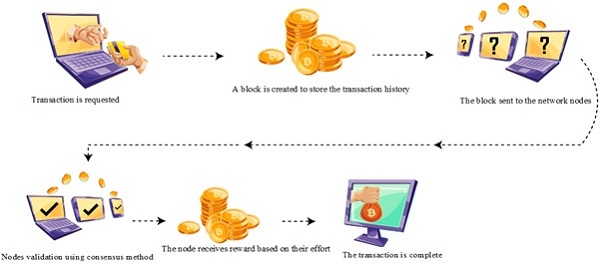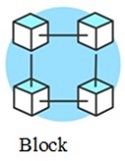Home »
Blockchain
What is Blockchain?
Blockchain Tutorial | All about blockchain that you need to know. In this tutorial, we will learn about what is blockchain, block in a blockchain, how does blockchain work, why blockchain is important, and blockchain architecture.
By IncludeHelp, on July 02, 2023
Before study the blockchain, I would like to let you know some key points:
- The blockchain is a technology, not a Bitcoin; Bitcoin is an application of Blockchain.
- Blockchain is a digital ledger that keeps transactions of digital tokens or cryptocurrency; Bitcoin is a cryptocurrency.
- Without blockchain, we cannot think about Bitcoin but blockchain can successfully run without Bitcoin.
Let's start Blockchain learning!
What is Blockchain?
A blockchain is a distributed ledger that stores information in such a way that it is difficult or impossible to alter the data, hack the system, or deceive it.
A blockchain is simply a digital log of transactions that spreads throughout a computer network to make a blockchain. This makes the blockchain very secure. Every block in the chain stores a number of transactions and whenever a new transaction takes place on the blockchain, a record of that transaction is added to the ledgers of all of the participants in the network.
A blockchain is also referred as a "Distributed Ledger Technology" that records transactions and all the blocks in the chain are securely linked together via cryptographic hashes.
What is block in a Blockchain?
In a Blockchain, blocks are like containers that hold records of transactions. For example, in Bitcoin transactions, a transfer of bitcoins is a transaction and this transaction history is stored in a block. On some blockchains, blocks also contain other types of information, like the code of computer programs.
Once a transaction is included in the block, it cannot be removed. Moreover, a block that has been added to the chain cannot be altered. If the blockchain is in operation, information stored in blocks will be there. Blocks are linearly stacked one on top of the other. They link together to establish a chain that contains every transaction that has taken place on the network.
Every chain consists of multiple blocks and each block has three basic elements:
- The data block in the block.
- The nonce - A nonce in the blockchain is a whole number that is randomly generated when a block is created and then generates a block header hash.
- The hash - a hash in the blockchain is a number permanently attached to the nonce.
When the first block of a chain is created, a nonce generates the cryptographic hash. The precise block structure may vary from blockchain to blockchain.
How does Blockchain work?
The following sequence of steps is demonstrating the working of blockchain -
- In the first step, a Transaction is requested. The transaction can be either to transfer money or information.
- A block is created to store the transaction history. However, the transaction is not validated yet.
- The block which has transaction details is now sent to the network nodes. If it is a public blockchain, it is sent to each node. Each block in the chain contains data value, the previous block hash number, and the current block hash.
- In this step, the nodes are validated using the consensus method. For example, in Bitcoin, Proof-of-Work (PoW) is used.
- After successful validation, the node now receives a reward based on its effort.
- The transaction is now complete.

Fig: Blockchain working
Why Blockchain is important?
Blockchain is a ledger of all cryptocurrency transactions. This is a prospective technological advancement that has changed business scenarios and may perhaps have significant effects on society as a whole. Here are some of the key reasons to show the significance of Blockchain Technology:
- It is immutable, meaning that once a transaction is recorded, it cannot be changed.
- Transactions are completed instantly and transparently because the ledger is updated automatically.
- It is a decentralized system.
- There is no intermediary fee.
- The authenticity of a transaction is verified and confirmed by participants.
Blockchain Architecture
Architecture is a combination of different components. Blockchain architecture is made up of the following components:
- Transaction
- Block
- Network
- Consensus

Fig: Blockchain architecture
1. Transaction
Blockchain transactions are its smallest units. They usually have a sender, receiver, and value information. The value is transferred when the owner digitally signs the hash that results when the previous transaction is added to the public key of the recipient.

When the transaction is publicly publicized, all nodes separately keep a copy of it and determine the current "state" by processing each transaction in order as it appears in the blockchain. Blocks send transactions to nodes. Each node individually verifies and "processes" new transactions.
2. Block
Block is just like a container which consists information as a block header and transactions. Blocks transmits and are replicated transaction data to all nodes over the P2P network. In Blockchain, all the blocks created by "miners" and the process to create a block called "mining".

Fig: Interconnected blocks
Types of Blocks
The blocks are mainly categorized into three parts -
- Main branch blocks: These blocks extend the current main blockchain and make the longest chain in the network.
- Side branch blocks: These blocks make a chain with its parent block which is not the longest blockchain.
- Orphan blocks: These blocks are connected to a parent block which is unknown to the node processing the block.
3. Network
The blockchain follows a peer-to-peer (P2P) network which is based on IP protocol. A peer-to-peer network is secure as this network does not have a single point of attack or failure as compared to a centralized network.
A blockchain network can either be a permission-based network or a permissionless network. A permissionless network is a public blockchain and anyone may join this network. On the other hand, a blockchain that requires participants to obtain permission is known as a consortium blockchain. A permission-based blockchain, also known as a private blockchain, this network does pre-verification of users, and the participants are often familiar with one another.
4. Consensus
The consensus is a mechanism that uses computer programming algorithms that ensures that whatever local copy every individual in the network has, they are consistent with each other and updated.
Advertisement
Advertisement